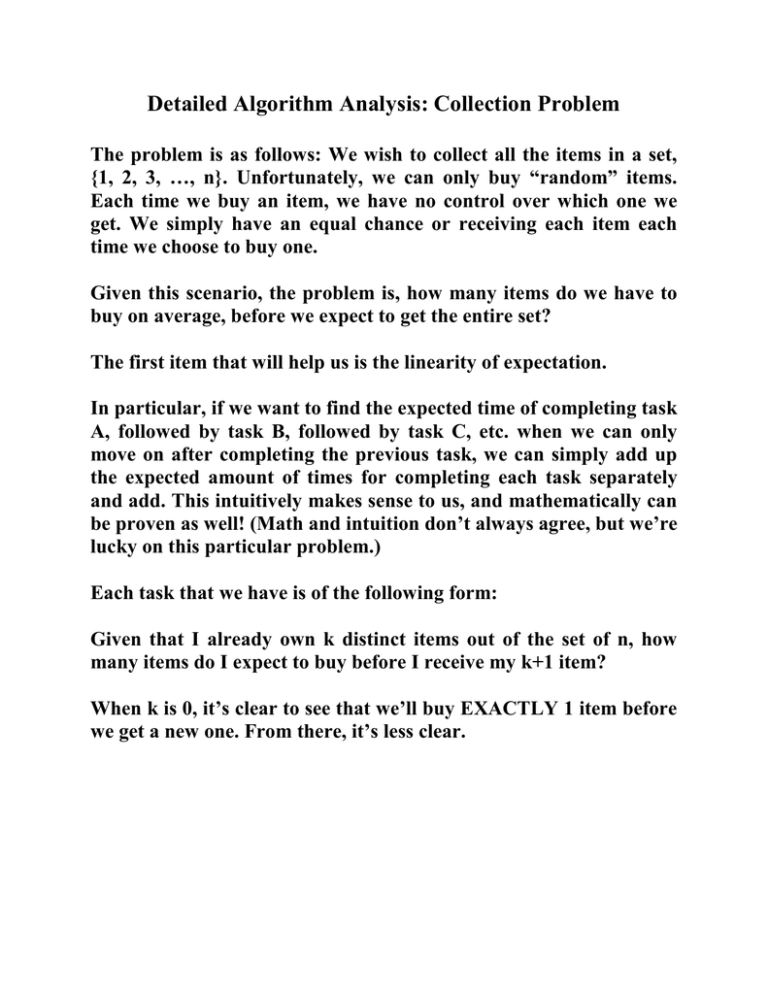Detailed Algorithm Analysis: Collection Problem
advertisement

Detailed Algorithm Analysis: Collection Problem
The problem is as follows: We wish to collect all the items in a set,
{1, 2, 3, …, n}. Unfortunately, we can only buy “random” items.
Each time we buy an item, we have no control over which one we
get. We simply have an equal chance or receiving each item each
time we choose to buy one.
Given this scenario, the problem is, how many items do we have to
buy on average, before we expect to get the entire set?
The first item that will help us is the linearity of expectation.
In particular, if we want to find the expected time of completing task
A, followed by task B, followed by task C, etc. when we can only
move on after completing the previous task, we can simply add up
the expected amount of times for completing each task separately
and add. This intuitively makes sense to us, and mathematically can
be proven as well! (Math and intuition don’t always agree, but we’re
lucky on this particular problem.)
Each task that we have is of the following form:
Given that I already own k distinct items out of the set of n, how
many items do I expect to buy before I receive my k+1 item?
When k is 0, it’s clear to see that we’ll buy EXACTLY 1 item before
we get a new one. From there, it’s less clear.
Expected Number of items to buy to get ONE new item
Let X equal the expected number of items we must buy to obtain our
k+1 distinct item.
If we are lucky, which will happen (n – k)/n of the time, we will
ONLY have to buy 1 item.
The other k/n of the time, we will have bought one item and be no
better off than if we had bought none. In this case, we expect to buy
X+1 items, the X being the average number we expect to buy from
this point on, and the 1 representing this repeated item we just
bought.
This gives us the following equation:
X = (n – k)/n*1 + k/n*(X+1)
The idea is that these are two separate expressions for the same
expectation. The LHS is simply the variable we designated for this
value while the RHS is broken down into the two distinct
probabilities of what happens when we buy our first item after we
have k distinct ones.
Now, solve this equation for X:
X = (n – k)/n*1 + k/n*(X+1)
X = (n – k)/n + k/n*X + k/n
X – k/n*X = (n – k + k)/n
X(1 – k/n) = n/n
X((n – k)/n) = 1
X = n/(n – k)
Thus, we can expect to buy n/(n-k) items to receive our k+1 item.
Solving the Problem
Thus, we know that we expect to buy 1 item to get our first new
item, n/(n – 1) items to get our second item, n/(n – 2) items to get our
third new item, etc.
Using the linearity of expectation, to figure out the total number of
items we need to buy, we get the following sum:
n/n + n/(n – 1) + n/(n – 2) + n/(n – 3) + … + n/1
Factoring n out of this expression, we get:
n(1/n + 1/(n – 1) + 1/(n – 2) + 1/(n – 3) + … + 1/1)
The sum inside the parentheses is known as the Harmonic Sum.
A little bit of calculus can be used to show that this sum is very close
to the value ln n. Thus, we find that the total number of items we
must buy (on average) to get the whole set is very close to nln.
(In particular, we can represent the sum as n rectangles along the xaxis with width 1 and heights 1, ½, 1/3, etc. The sum of the areas of
these rectangles equals the value of this sum. We can get an upper
and lower bound on the area of these rectangles by drawing the
functions f(x) = 1/x and f(x) = 1/(x+1) and seeing how they interact in
relation to the rectangles. Getting the areas under these curves
within the designated ranges is fairly easy using calculus and gives
us good tight approximations to the sum.)
Code to Simulate the Process
int buyWholeSet(int n) {
int numDistinct = 0;
int numSteps = 0;
int* gotIt = (int*)malloc(sizeof(int)*n);
int i;
for (i=0; i<n; i++)
gotIt[i] = 0;
while (numDistinct < n) {
numSteps++;
int item = ((1 << 15)*rand() + rand())%n;
if (gotIt[item] == 0) {
gotIt[item] = 1;
numDistinct++;
}
}
free(gotIt);
return numSteps;
}
/*
Note: Since rand() only returns numbers upto
32767, in order to create random item numbers
beyond this, bitshifting is used to create a
random number that can approach 2 to the 30
power.
*/





